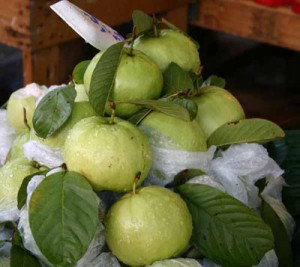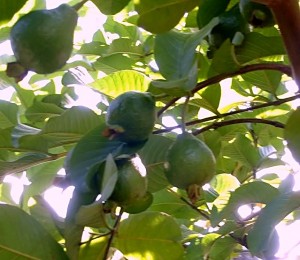 Giant Guava or Guapple as they call it here in the Philippines is a very profitable cash crop if quality produced. Guapple is a non-seasonal or everbearing variety which attracts some people from Negros province. It weighs an average of 400 to 1,000 grams per fruit. It produces thick and white-freshed fruit but with bland taste. However, this variety is crispy in flesh texture.
Giant Guava or Guapple as they call it here in the Philippines is a very profitable cash crop if quality produced. Guapple is a non-seasonal or everbearing variety which attracts some people from Negros province. It weighs an average of 400 to 1,000 grams per fruit. It produces thick and white-freshed fruit but with bland taste. However, this variety is crispy in flesh texture.
The tree excels most other fruit trees in productivity, hardness and adaptability. Its tree type is relatively spreading in growth habit with four-angled branches, leaves are opposite, oblong to elliptical in shape with pointed apex and base which are usually rounded and light green in color. This variety was collected from Thailand.
Economic Importance:
- Fresh fruit is eated raw, a good source of Vitamin C.
- Fruits can be processed into jelly, wine, guava jam preserves.
- Decoction of 25 leaves in 2 glasses of water is a good cure for diarrhea, as astringent, mouthwash for swollen gums, antipyretics, reduce fever and anti-spasmodic.
- Bark and leaves are used in child-birth to expel the placenta. The bark is recommended in making complex cosmetics for what seems to be hysteroepilepsy.
- Young tender leaves chewed or crushed applied to tooth cavity acts as eugenol for toothaches.
How to grow Giant Guava or Guapple
Soil and Climatic Requirement
Guava can be grown best in a well-drained clay loam to sandy loam rich in organic matter with pH ranging form 6.0 to 6.5 and display some tolerance to salinity. Prefers dry climate with well-distributed rainfall throughout the year. Moreover, they are more drought resistant than most tropicalfruit trees. Elevation ranging from sea level to 500 feet above sea level.
Recommended Cultural Requirement
The soil for the seedbox should be sterilized first by using heat or pouring boiled water. Soil mixture should be 1/3 sand, 1/3 garden soil, 1/3 sawdust humus. Purpose of sterilization is to eliminate organisms found in the soil. Place in desired sizes of seedboxes or in individual small plastic bags.
Planting Materials
Fresh seeds should be sun-dried first for a day to break the dormancy period and hasten germination within 15 days.
In asexual propagation, marcotting is done using branches or stem of 1/2 inch in diameter. When roots appear, cut marcots and plant in plastic bags.
For bud/cleft grafting, when the scion has successfully germinated cut stock and put under the surface. Tend these planting materials under the shades for at least 2 weeks to enhance easy adaption to environment before planting them in the open field or orchard. Seedlings are ready for transplanting after 6 months when they are 30 cm high.
Guava are open-pollinated and they produce seedlings which are available in fruit and tree characteristics. Use asexual propagation by marcotting and bud/cleft grafting as planting materials to produce high yield of desirable fruits. Variability in seedlings can be minimized by hand self-pollination of individual flowers designated for seed production.
Land Preparation
The land should be plowed once followed by two harrowings until excellent condition for planting is attained. For newly opened land, underbrushed branches and twigs should be burned before the holes are dug.

Planting and Spacing
Holes, 2 x 2 x 2 feet are dug and refilled with manure or compost. Plant three (3) months old seedling at the onset of the rainy season. The distance of planting is 3m x 3m. A hectare will require 1,111 planting materials.
Irrigation
The plants do not need intensive irrigation, but in ares with a longer dry season, the orchard should be irrigated every 5-7 days. This way, trees can be fruitful throughout the year.
Cultivation and Weeding
Young trees do not require much cultivation. Weeding and loosening of the soil periphery of its foliage to a depth about 2-3 cm should be done before the time of fertilizer application. Maintain sanitation or clean culture.
Pruning
The pinching or terminal buds is necessary as new young leaves start to come out after planting. The purpose is to initiate more new productive branches.
Flowering and Thinning
The plants will start flowering as early as eight (8) months from planting. Some of the young fruits should be removed and thinned retaining only at least five (5) fruits for a year old tree. The purpose is to produce big fruits weighing one kilo per fruit.
Fertilization
The trees should be fertilized with both composed organic manure and inorganic fertilizer manure. It is placed at the bottom of the hole and on the periphery of the roots.
Age of Plants / Rate / Method of Application
- Planting / 100-150 grams of complete fertilizer (14-14-14) / Apply 2 in the roots and to sides
- Young trees / 200-300 grams / Apply by digging shallow furrow along the periphery of the canopy
- Bearing trees / 300 grams to 1 kg of complete fertilizer plus 300 grams of 0-0-60 and 16-20-0 / – same –
Intercropping
To minimize use of the land, intercropping is highly recommended. Raising annual crops such as vegetables, legumes, ginger, gabi for the first year after planting, give the farmers an additional income from the orchard as well as suppresses the growth of weeds.
Control of Pest and Diseases
Pest and their control:
- Oriental fruitfly – The larvae of the fruitflies burrow through ripe fruits making them unfit for human consumption. Control: Spray with Malathion on a monthly intervals or with Sevin 85, as directed.
- Aphids – These feed on young growth causing curling of leaves. Control: Spray with Malathion or Sevin
- White flies – These feed on either surface or mature leaves. Control: spray with phosphatic insecticide.
Disease and their control
Anthracnose and fruit canker – spotting of fruits ad leaves.Control: Spray with fungicides (copper zinc or Bordeaux mixture, benlate) Remove all affected fruits and bum.
Harvesting
Harvest when the preferable market weight is about 300-500 grams per fruit. It is done by pulling the fruits from the twig. A matured fruit of this variety weigh 1,000 grams.
Production
The tree on its first year fruiting can yield about 15 kilos weight which cost 15.00 per kilo (2001 market price). On the second year 45 kilos and succeeding year about 60 kilos and more.
For 200 trees, it can gross around P140,000 per year and the cost of production for P35,000 per hectare covering the expenses on the cost of seedlings, water system, labor, fertilizer, insecticide, fungicide, weeding and others.
Sources: www.da.gov.ph
What’s a natural pesticides?